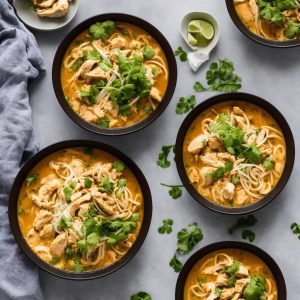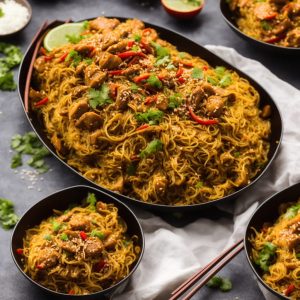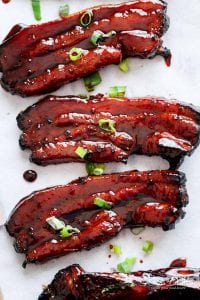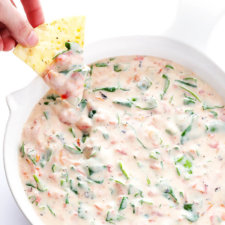Indulge in the fragrant and spicy world of Southeast Asia with this authentic Singapore Laksa recipe. Often found in the hawker centers of Singapore, this rich and creamy dish combines the punchy flavours of chili, turmeric, and lemongrass with the sweetness of coconut milk and prawns, creating a comforting bowl that is sure to delight your palate.
This recipe calls for ingredients like blue ginger, candle nuts, and laksa leaves which may not be commonly found in every kitchen. Blue ginger, also known as galangal, has a sharper flavor compared to regular ginger and is a staple in Southeast Asian cuisine. Also, candle nuts, used as a thickening agent, have a slightly sweet and creamy flavor, while the laksa leaves, commonly known as Vietnamese coriander, offer a spicy, minty kick.
Ingredients for Singapore Laksa Recipe Excluding Measurements
King prawns: A type of large shrimp, they are known for their sweet and delicate flavour.
Palm sugar: Derived from the sap of the palm tree, it adds a rich caramel-like sweetness to the dish.
Coconut milk: Provides a creamy base and sweet, rich flavor.
Tofu puffs: Fried tofu pieces that are light and soak up flavours well.
Chillies: Adds heat to the dish.
Dried shrimp: Adds a seafood taste to the dish.
Shrimp paste: A fermented condiment that adds a strong umami flavour.
Garlic: Provides a pungent, spicy flavour.
Ginger: Offers a warm and spicy flavour.
Blue ginger: Similar to ginger but has a sharper flavor.
Turmeric: Adds a warm, bitter flavour and vibrant colour.
Candle nuts: Used as a thickening agent and provide a slightly sweet, creamy flavour.
Lemongrass: Gives a lemony flavour with hints of ginger.
Vermicelli rice noodle: Thin noodles made from rice, they absorb flavours well.
Bean sprout: Adds a crunchy texture.
Fish cake: A processed seafood product that has a slightly sweet, savoury flavour.
Cockles: Small shellfish that add a briny flavour.
Laksa leaves: Also known as Vietnamese coriander, adds a spicy, minty kick.
One reader, Georas Kovach says:





This Singapore laksa recipe is a game-changer! The flavors are rich and authentic, and the prawn stock adds a delicious depth. The laksa paste is a labor of love, but the end result is totally worth it. A must-try for anyone craving a taste of Singapore at home!
Techniques for Crafting Singapore Laksa
How to prepare prawn stock: Simmer prawn heads and shells in water and chicken stock for 45 minutes, then strain the broth through a sieve.
How to make laksa paste: In a food processor, pulse together dried chillies, red chillies, dried shrimp, shrimp paste, garlic, shallot, ginger, blue ginger, turmeric root, candle nuts, and lemongrass until a thick paste forms.
How to cook laksa: In a large saucepan, cook the laksa paste until fragrant, then add palm sugar, fish sauce, coconut milk, and prawn stock. Simmer for 15 minutes, then add prawns and tofu puffs and cook for an additional 3 minutes.
How To Make Singapore Laksa
A spicy with a refreshing dose of coconut milk for an amazing combination of flavors! This Singapore laksa recipe is sure to fire up your tastebuds.
Serves:
Ingredients
- 8king prawnsde-shelled
- 1tbsppalm sugar
- 1tbspfish sauce
- 1¼cupscoconut milk
- ¼lbtofu puffstau pok, halved
- 2tbspcooking oil
For Prawn Stock:
- 8king prawnshead and shells
- 5cupswater
- 2cupschicken stock
- 2tbspcooking oil
For Laksa Paste:
- 15chilliesdried
- 2redchillies
- 3tbspdried shrimpsoaked
- 1tbspshrimp paste
- 8clovesgarlic
- 1shallot
- 1ginger
- 1blue gingergalangal, about 1-in
- 2root turmeric
- ¼cupcandle nuts
- 1stalklemongrass
For Serving:
- 2cupsvermicelli rice noodlecooked
- 1cupbean sproutblanched
- 1fish cakesliced, heated
- 8cockles
- 1bunchlaksa leaves
- 2tbspchilli paste
Instructions
-
Remove the heads and shells from prawns and set aside in a bowl, then devein and set the prawn meat aside in a separate bowl.
Prawn Stock:
-
Add cooking oil to a large saucepan on medium-high heat.
-
Add prawn heads and shells then stir for 5 minutes, crushing the heads to release the flavour.
-
Add water and chicken stock, then simmer for 45 minutes allowing the stock to reduce.
-
Remove prawn shells then strain the broth into a bowl through a sieve.
Laksa Paste:
-
In a food processor, add dried chilli, red chilli, dried shrimp, shrimp paste (belacan), garlic, shallot, ginger, blue ginger (galangal), turmeric root, candle nuts and lemongrass stalk, then pulse for 5 minutes until a thick paste forms.
-
Add cooking oil to a large saucepan then add the laksa paste and cook for 5 minutes until fragrant.
-
Add palm sugar, fish sauce, coconut milk and prawn stock stirring to combine. Simmer the mixture for 15 minutes then add the prawns and tofu puffs, cooking for 3 minutes to finish.
-
To serve, add vermicelli noodles to a bowl then top with bean sprouts, cockles and slices of fish cake.
-
Ladle in scoops of the laksa making sure to include tofu puffs and prawns. Top with a handful of finely chopped laksa leaves and optional chilli paste.
-
Enjoy!
Nutrition
- Calories: 2912.99kcal
- Fat: 84.46g
- Saturated Fat: 33.76g
- Trans Fat: 0.12g
- Monounsaturated Fat: 29.97g
- Polyunsaturated Fat: 15.72g
- Carbohydrates: 459.40g
- Fiber: 19.76g
- Sugar: 36.60g
- Protein: 79.79g
- Cholesterol: 149.10mg
- Sodium: 3282.63mg
- Calcium: 551.85mg
- Potassium: 2938.84mg
- Iron: 25.44mg
- Vitamin A: 260.16µg
- Vitamin C: 569.47mg
Crucial Technique for Perfecting Laksa
When making the laksa paste, it's important to pulse the ingredients in the food processor until they form a thick paste. This ensures that the flavors are well combined and evenly distributed throughout the dish. If the paste is too thin, it may not coat the other ingredients properly, resulting in a less flavorful laksa. If you find that your paste is too thin, try adding a few more candle nuts or a bit more dried shrimp. These ingredients will help to thicken the paste without altering the flavor profile too much.
Time-Saving Tips for Singapore Laksa Recipe
Prep ahead: Chop and prepare all your ingredients in advance to streamline the cooking process.
Organize your workspace: Keep your kitchen organized and clean as you cook to save time and minimize stress.
Multi-task: Utilize your time efficiently by working on multiple components of the recipe simultaneously.
Use kitchen gadgets: Invest in time-saving kitchen tools such as food processors, blenders, and mandolines to expedite the cooking process.
Follow the recipe: Read through the entire recipe before you start cooking to understand the steps and plan your time effectively.
Clean as you go: Wash and put away utensils and dishes as you cook to maintain an organized kitchen and save time on cleanup later.
Batch cooking: Consider making larger quantities of the recipe and freezing the extra portions for quick and convenient meals in the future.
Substitute Ingredients For Singapore Laksa Recipe
king prawns - Substitute with shrimp: Shrimp can be used as a substitute for king prawns in the laksa recipe. They have a similar sweet and briny flavor and will work well in the dish.
palm sugar - Substitute with brown sugar: Brown sugar can be used as a substitute for palm sugar in the laksa recipe. It provides a similar sweetness and caramel flavor to the dish.
fish sauce - Substitute with soy sauce: Soy sauce can be used as a substitute for fish sauce in the laksa recipe. It adds a savory umami flavor and saltiness to the dish.
coconut milk - Substitute with coconut cream: Coconut cream can be used as a substitute for coconut milk in the laksa recipe. It has a thicker consistency and will provide a richer flavor to the dish.
tofu puffs - Substitute with fried tofu cubes: Fried tofu cubes can be used as a substitute for tofu puffs in the laksa recipe. They offer a similar texture and absorb the flavors of the dish well.
cooking oil - Substitute with coconut oil: Coconut oil can be used as a substitute for cooking oil in the laksa recipe. It adds a hint of coconut flavor to the dish.
chillies - Substitute with jalapeños: Jalapeños can be used as a substitute for chillies in the laksa paste. They provide a similar level of heat and a slightly different flavor profile.
dried shrimp - Substitute with anchovy paste: Anchovy paste can be used as a substitute for dried shrimp in the laksa paste. It adds a savory, umami flavor to the dish.
shrimp paste - Substitute with miso paste: Miso paste can be used as a substitute for shrimp paste in the laksa paste. It provides a similar depth of flavor and adds a rich umami taste to the dish.
candle nuts - Substitute with macadamia nuts: Macadamia nuts can be used as a substitute for candle nuts in the laksa paste. They have a similar creamy texture and mild, nutty flavor.
lemongrass - Substitute with lemon zest: Lemon zest can be used as a substitute for lemongrass in the laksa paste. It provides a citrusy aroma and flavor to the dish.
vermicelli rice noodle - Substitute with soba noodles: Soba noodles can be used as a substitute for vermicelli rice noodles in the laksa recipe. They offer a similar thin, delicate texture and are a good alternative.
bean sprout - Substitute with snow peas: Snow peas can be used as a substitute for bean sprouts in the laksa recipe. They provide a crunchy texture and a fresh, green flavor to the dish.
fish cake - Substitute with crab sticks: Crab sticks can be used as a substitute for fish cake in the laksa recipe. They offer a similar seafood flavor and texture.
cockles - Substitute with clams: Clams can be used as a substitute for cockles in the laksa recipe. They provide a similar briny flavor and can be used as a seafood alternative.
laksa leaves - Substitute with cilantro: Cilantro can be used as a substitute for laksa leaves in the laksa recipe. It adds a fresh, herbal flavor to the dish.
chilli paste - Substitute with sambal oelek: Sambal oelek can be used as a substitute for chilli paste in the laksa recipe. It provides a similar level of heat and a tangy, spicy flavor.
Presenting Singapore Laksa
Elevate the prawns: Arrange the king prawns in a visually appealing manner, ensuring they are the focal point of the dish. The prawns should be positioned to showcase their vibrant color and succulent texture.
Garnish with fresh laksa leaves: Sprinkle freshly chopped laksa leaves over the dish to add a pop of vibrant green color and a burst of aromatic flavor. The leaves should be delicately placed to enhance the overall presentation.
Incorporate artistic swirls of coconut milk: Use a fine drizzling technique to create elegant, artistic swirls of coconut milk around the perimeter of the bowl. The swirls should be meticulously crafted to add a touch of sophistication to the presentation.
Arrange the vermicelli noodles with precision: Carefully arrange the vermicelli rice noodles in a neat, organized manner, ensuring they are evenly distributed and form an aesthetically pleasing base for the dish.
Utilize decorative plating: Select a visually striking bowl or plate to present the Singapore Laksa, enhancing the overall visual appeal of the dish. The choice of plating should complement the vibrant colors and textures of the ingredients.
Incorporate a touch of heat with chili paste: Add a small, carefully measured amount of chili paste to the dish, creating a visually captivating contrast and hinting at the dish's bold flavors. The chili paste should be strategically placed to add a touch of heat without overpowering the presentation.
Highlight the tofu puffs: Position the tofu puffs in an eye-catching arrangement, ensuring they are evenly distributed and contribute to the overall visual balance of the dish. The tofu puffs should be showcased as a key element of the presentation.
Emphasize the fish cake slices: Artfully position the fish cake slices to create an appealing visual arrangement, drawing attention to their unique shape and texture. The slices should be placed thoughtfully to enhance the overall composition of the dish.
Essential Tools for Making Laksa
- Food processor: A food processor is a versatile kitchen appliance that can be used for chopping, slicing, shredding, and pureeing ingredients. It's great for making laksa paste and other spice blends.
- Large saucepan: A large saucepan is essential for making the prawn stock and simmering the laksa broth. It allows for even heat distribution and ample space for liquid ingredients.
- Sieve: A sieve is used to strain the prawn stock, removing any impurities and creating a clear, flavorful broth for the laksa.
- Cooking oil: Cooking oil is necessary for sautéing and frying ingredients. It helps to prevent sticking and adds flavor to the dish.
- Spatula: A spatula is useful for stirring and combining ingredients in the saucepan, ensuring that the laksa paste and broth are well mixed.
- Bowls: Various bowls are needed for separating prawn heads and shells, deveining prawns, and serving the laksa. They are essential for organizing and preparing ingredients.
- Knife: A sharp knife is essential for deveining prawns, slicing ingredients, and preparing the laksa paste. It's a versatile tool for precise cutting.
- Chopping board: A chopping board provides a stable surface for cutting and preparing ingredients. It helps to protect countertops and ensures safe and efficient food preparation.
- Blender: A blender can be used to blend the laksa paste ingredients if a food processor is not available. It helps to create a smooth and consistent paste.
- Measuring cups and spoons: Accurate measurements are crucial for achieving the right balance of flavors in the laksa. Measuring cups and spoons ensure precision in adding ingredients such as palm sugar, fish sauce, and coconut milk.
- Ladle: A ladle is essential for serving the laksa, allowing for easy portioning of the broth, prawns, and tofu puffs into individual bowls.
- Tongs: Tongs can be used for handling and turning ingredients such as tofu puffs and prawns while cooking. They provide a secure grip and prevent splattering.
- Pot: A pot may be used for boiling vermicelli rice noodles and blanching bean sprouts. It's essential for preparing these components of the laksa dish.
- Strainer: A strainer can be used to rinse and drain the vermicelli rice noodles and bean sprouts, ensuring that they are clean and ready for serving.
Storing and Freezing Homemade Laksa
Here are the detailed storing and freezing guidelines for Singapore laksa:
- Allow the laksa to cool completely before storing. Transfer to an airtight container and refrigerate for up to 3-4 days.
- To reheat, transfer the desired portion to a saucepan and heat over medium heat until warmed through. You may need to add a splash of chicken stock or coconut milk to thin out the sauce if it has thickened too much.
- For longer storage, transfer the cooled laksa to a freezer-safe container and freeze for up to 2-3 months. Thaw overnight in the refrigerator before reheating.
- It's best to store the vermicelli noodles, bean sprouts, and other toppings separately from the laksa broth. Store them in separate airtight containers in the refrigerator and add them to the reheated laksa just before serving.
- If you have any leftover laksa paste, you can store it in an airtight container in the refrigerator for up to 1 week or in the freezer for up to 2 months. Use it to make another batch of laksa or add it to other dishes like stir-fries or curries for extra flavor.
How To Reheat Leftover Laksa
- Reheat the laksa broth in a saucepan over medium heat until it reaches a simmer. Stir occasionally to prevent the coconut milk from separating.
- If the broth seems too thick, add a splash of chicken stock or water to thin it out.
- In a separate pot, bring water to a boil and briefly cook the vermicelli noodles until they are heated through. Drain the noodles and divide them among serving bowls.
- Arrange the tofu puffs, fish cake slices, and cockles on top of the noodles in each bowl.
- Microwave the prawns for 30-60 seconds, or until they are heated through. Place the heated prawns on top of the other ingredients in the serving bowls.
- Ladle the hot laksa broth over the noodles and toppings in each bowl.
- Garnish with fresh bean sprouts and finely chopped laksa leaves.
- If desired, serve with a dollop of chilli paste on the side for added heat.
- For best results, reheat and assemble the components of the laksa just before serving to maintain the texture and flavors of the dish.
- If you have leftover laksa paste, you can store it in an airtight container in the refrigerator for up to a week, or in the freezer for up to a month, for future use.
Interesting Trivia About Singapore Laksa
Singapore Laksa is a popular Peranakan dish that combines Chinese and Malay flavors. It is a spicy noodle soup that features a rich and aromatic coconut milk-based broth. The dish is known for its complex and flavorful laksa paste, which is made from a variety of ingredients such as dried shrimp, lemongrass, and turmeric. The use of prawns and tofu puffs in the recipe adds a delightful texture and taste to the dish.
Is Making Laksa at Home Cost-Effective?
This Singapore Laksa recipe can be cost-effective for a household. The use of affordable ingredients like prawns, tofu puffs, and vermicelli noodles makes it budget-friendly. However, the cost may vary based on the availability of certain items such as laksa leaves and cockles. The overall verdict for this recipe is 9/10, considering its rich flavors and versatility. The approximate cost for a household of 4 people is around $25-$30, making it a reasonable option for a delicious and satisfying meal.
Is Singapore Laksa Healthy or Unhealthy?
The Singapore Laksa recipe is a flavorful and aromatic dish, but it may not be the healthiest option due to several factors:
- The recipe includes a significant amount of coconut milk, which is high in saturated fat. Consuming too much saturated fat can increase the risk of heart disease and other health issues.
- The dish also contains palm sugar and fish sauce, both of which are high in sugar and sodium, respectively. Excessive sugar and sodium intake can lead to various health problems, such as obesity, diabetes, and hypertension.
- The recipe calls for deep-frying the tofu puffs, adding extra fat and calories to the dish.
- While prawns are a good source of protein, they are also relatively high in cholesterol.
To make the Singapore Laksa recipe healthier, consider the following suggestions:
- Replace some or all of the coconut milk with a lower-fat alternative, such as light coconut milk or a mixture of coconut milk and vegetable stock.
- Reduce the amount of palm sugar and fish sauce used in the recipe, or substitute them with healthier alternatives like coconut sugar and reduced-sodium soy sauce.
- Instead of deep-frying the tofu puffs, try baking or pan-frying them with minimal oil to reduce the fat content.
- Incorporate more vegetables into the dish, such as bok choy, carrots, or bell peppers, to increase the fiber and nutrient content.
- Use whole grain noodles instead of refined vermicelli rice noodles to add more fiber and complex carbohydrates to the dish.
- Opt for leaner protein sources, such as chicken or tofu, to reduce the cholesterol content of the dish.
Editor's Take on This Laksa Recipe
The Singapore Laksa recipe you provided is a classic and flavorful dish. The combination of aromatic spices, creamy coconut milk, and fresh seafood creates a harmonious and satisfying meal. The method of making the prawn stock from scratch adds depth of flavor, and the homemade laksa paste ensures an authentic taste. The addition of tofu puffs and various toppings adds texture and complexity to the dish. Overall, this recipe is a wonderful representation of the rich and diverse flavors of Singaporean cuisine.
Enhance Your Singapore Laksa Recipe with These Unique Side Dishes:
Delicious Alternatives to Singapore Laksa
Appetizers and Desserts to Complement Singapore Laksa Recipe
Why trust this Singapore Laksa Recipe:
This recipe for Singapore Laksa is a true taste of Singaporean cuisine. The rich and aromatic laksa paste is made from scratch, ensuring the freshest and most authentic flavors. The use of king prawns and homemade prawn stock adds depth and complexity to the dish. The inclusion of tofu puffs and a variety of traditional ingredients such as lemongrass and galangal further enhances the dish's authenticity. With a carefully crafted balance of spices and coconut milk, this recipe promises to deliver a truly satisfying and flavorful dining experience.
Was this page helpful?
Have your own special recipe to share? Submit Your Recipe Today!














